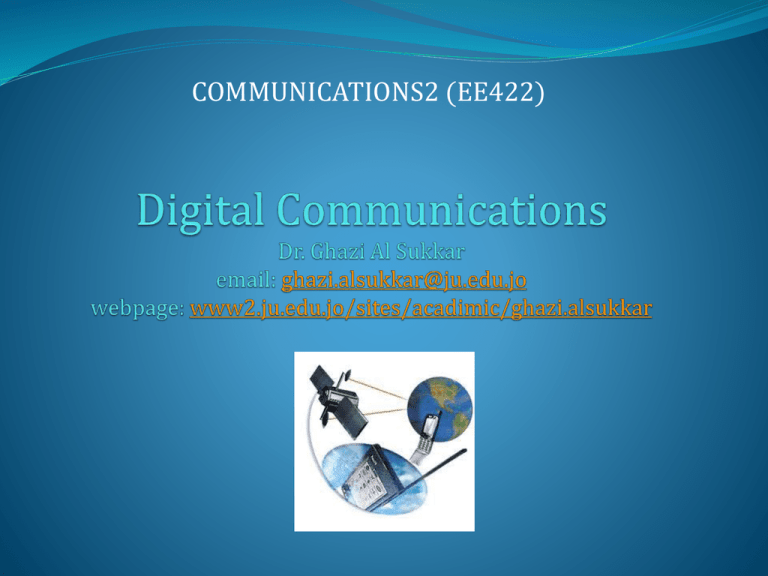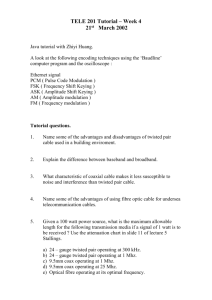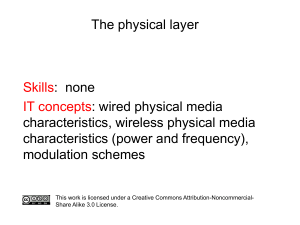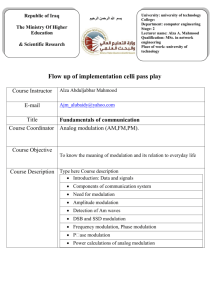Part0
advertisement

COMMUNICATIONS2 (EE422) Course Information: Instructor: Dr. Ghazi Al Sukkar. Email: ghazi.alsukkar@ju.edu.jo Office: E315 Website: www2.ju.edu.jo/sites/acadimic/ghazi.alsukkar Office Hours: See website. Prerequisites: EE421 Textbook: Modern Digital and Analog communication Systems, fourth edition, by: B.P. Lathi and Zhi Ding, fourth edition, 2009. Readings: Probability and Random Variables (Ch8 and Ch9) “first and second quizz” Dr. Hawa handouts: Line coding (first exam). Digital Modulation Techniques (second exam). 2 Course Syllabus: Introduction: history of telecommunicatios. Baseband Digital Systems: Line coding Pulse shapping and ISI Passband Digital Systems: Digital Modulation Techniques. Digital Modems. Digital Systems Performance. Optimum receivers. Symbol error rates. Spread Spectrum Techniques. FHSS DSSS Orthogonal Frequency Division Multiplexing. For details see: http://www2.ju.edu.jo/sites/Academic/ghazi.alsukkar/Material/Form s/AllItems.aspx 3 History of Communications The highlights of the inventions which have lead to communications as we know it today are listed below: 1440: Printing press - Gutenberg 1826: Ohm’s law - Ohm 1837: Line telegraphy invention - Gauss, Weber 1844: Line telegraphy patent - Morse 1858: 1st transatlantic cable (fails after 26 days) 1864: Electromagnetic radiation predicted – Maxwell 1866: Successful transatlantic telegraph cable (Valentia to Newfoundland) 4 Cont. 1875: Telephone invented - Bell 1877: Phonograph invented - Edison 1887: Detection of radio waves - Hertz 1894: Wireless communication over 150 yards - Lodge 1895: Wireless telegraphy - Marconi 1897: Automatic telephone exchange - Strowger 1901: Transatlantic radio transmission – Marconi 1904: Diode valve - Fleming 1905: Wireless transmission of speech and music Fesseden 5 Cont. 1906: Triode valve - de Forest 1907: Regular radio broadcasts 1915: Trans. USA telephone line - Bell System 1918: Superheterodyne radio receiver - Armstrong 1919: Commercial broadcast radio - KDKA Pittsburg 1920: Sampling applied to communications - Carson 1926: Television invented - Baird (UK), Jenkins (USA) 1928: All electronic television - Farnsworth 1928: Theory of transmission of telegraph - Nyquist 6 Cont. 1928: Information theory - Hartley 1933: FM demonstrated - Armstrong 1934: Radar - Kuhnold 1937: PCM (pulse code modulation) proposed - Reeves 1939: Commercial TV broadcasting - BBC 1943: Microwave radar used 1944: Statistical methods to describe noise and extract signals – Rice 1945: Geostationary satellites proposed - Clarke 7 Cont. 1946: ARQ (automatic repeat request) proposed Duuren 1948: Mathematical theories of communication Shannon 1948: Invention of transistor - Shockley, Bardeen, Brattain 1953: Transatlantic telephone cable 1955: Invention of laser - Townes, Schawlow 1961: Stereo FM transmission 8 Cont. 1962: Satellite communication - TELSTAR 1963: Touch tone telephone - Bell System 1963: Geostationary communications satellite SYNCOM II 1963: Error correction codes developed 1964: First electronic telephone exchange 1965: Commercial communications satellite - Early Bird 1966: optical fibre proposed - Kao, Hockman 1968: Cable TV 9 Cont. 1970: Medium scale data networks - ARPA/TYMNET 1970: LAN, MAN, WAN 1971: ISDN proposed - CCITT 1972: First cellular mobile phone 1974: The Internet - Cerf, Kahn 1978: Cellular radio 1978: Navstar GPS (global positioning system) 1980: Fibre optic communications system developed Bell System 1980: OSI 7 layer reference model - ISO 10 Cont. 1981: HDTV (high-definition television) demonstrated 1985: ISDN basic rate access introduced - UK 1986: SDH introduced (SONET in USA) 1991: GSM (global system for mobile Communications)- Europe 1999: WAP (wireless application protocol) 11 Communications System In its simplest form a telecommunications system consists of a transmitter, a channel, a receiver and two transducers. 12 Transducer Converts the input message into an electrical signal. Examples of transducers include: Microphone – converts sound to electrical signal Camera – converts image to electrical signal A transducer is also used to convert electrical signals to an output message (or approximation of the input message), e.g., sound, images etc. 13 Transmitter Converts electrical signal to a form that is suitable for transmission through the transmission medium or channel. Generally matching of signal to channel is done by modulation. Modulation uses the information (message signal) to vary the amplitude, frequency or phase of a sinusoidal carrier, e.g. amplitude/frequency modulation AM/FM. The transmitter also filters and amplifies the signal. 14 Receiver Recovers the message contained in the received signal Demodulates the message signal Filters signal and suppresses noise 15 Communication Modes There are a few basic modes of communication: Unicast: where one user wishes to communicate with one other user. Communication is normally two-way. Broadcast: Where one sender communicates with all capable receivers who cannot respond. The communication is therefore normally one-way. Multicast: One sender communicates with a nominated set of receivers who cannot respond. 16 Methods of Data Transmission There are a few basic methods of data transmission: Simplex: Data is transmitted in one direction only. The receiver cannot communicate with the sender. Duplex: Data transmission can take place in both directions simultaneously. Half-Duplex: Data transmission can take place in both directions but not at the same time. 17 Time Constraints There are generally two sets of time restraints; real- time or time-lapse: Real-Time: Real-time communication is instant and data must be sent and received simultaneously. An example of this is the telephone network or two-way radio communications. 18 Cont. If a conversation is to be maintained there must be immediate interaction between the talkers. Delays will make the conversation difficult or impossible. Time-Lapse: Data may be received at any time after having been sent. Examples include email, downloading a file from a central server or from the Internet. A delay of a few seconds or even minutes is acceptable. The time of receipt is not important. 19 Transmission Modes All transmission is analogue, in the sense that physical quantities (voltage, current, electromagnetic radiation) must vary in a smooth way. However, the representation of the underlying signals may be either analogue or digital. 20 Cont. 21 Cont. 22 Block Diagram of a Communication System: 23




